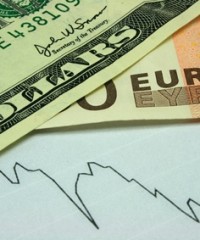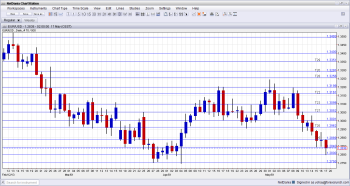EUR/USD: suffered a second week of significant falls after euro-zone figures disappointed and the dollar kept advancing. Is the pair ready to recover or are we going to see more drops? Flash PMI’s and German Ifo Business Climate are the highlights of this week. Here is an outlook for the main events and an updated technical analysis for EUR/USD.
Eurozone economic data was hit by a constant flow of disappointing GDP numbers, dragging the 17-country currency bloc to its longest-ever recession. Germany the leading force in Europe failed to meet market expectations, growing a mere 0.1% in March. France contracted 0.2% in March and officially fell back to recession. The EU as a whole declined by 0.2%. Is the recovery awaiting us in H2 as the ECB estimates? In the meantime, the central bank continues to check out the possibility of a negative deposit rate, and this weighs on the euro. In the US, data hasn’t been all rosy, but the economy continues growing.
- German PPI: Tuesday, 6:00. Manufacturers’ products inflation in Germany declined in March 0.2% on a monthly bases, following a 0.1% drop in February, driven by falling energy prices. Analysts expected a 0.1% climb. On a yearly basis, PPI gained 0.4% in March. A smaller drop of 0.1% is forecast. Lower inflation (now confirmed for the euro-zone) was one of the triggers for the rate cut.
- EU Economic Summit: Wednesday. European Union leaders will gather in Brussels under Irish presidency and discuss pressing budget and foreign policy issues of early 2013 and on to other challenges in the “European Council Priorities up to 2014.
- Current Account: Wednesday, 8:00. The euro zone’s current account surplus grew in February to EUR16.3 billion from EUR13.8 billion the previous month due to increased trade. January’s current account surplus was revised down to EUR13.8 billion from an initial estimate of EUR14.8 billion published in the previous month. A decline to EUR14.2 billion is expected now.
- Flash Manufacturing and services PMIs: Thursday: France begins at 7:00, Germany is next at 7:30 and figures for the euro-zone are released at 8:00. A sharp decline was registered in German business activity in April, down to 47.9 from 49 in March, while economists expected a reading of 49.0. Another decline occurred in Germany’s service sector, falling to 49.2 in April from 50.9 in the previous month raising concerns that the strongest EU nation is affected by the general slowdown. Meanwhile French figures were more optimistic. The manufacturing sector increased 0.4 points to 44.4, above predictions for a 44.2 reading and the service sector edged up to 44.1 from 41.3 in March, raising hopes of an emerging recovery process. Furthermore, Markit’s flash euro zone services PMI, rose to 46.6 in April from 46.4 in March, but the manufacturing sector declined slightly to 46.5 from 46.8 in March, still below the 50 point line, however, signaling that the worst is over. French Manufacturing PMI is expected to improve to 44.8 and the Service sector to climb to 11.7; German Manufacturing PMI is expected to reach 47.9 while the service sector is expected to cross the 50p point line reaching 50.2. Finally the Eurozone is also expected to improve with the manufacturing sector reaching 47.1 and the services sector reaching 47.4.
- Consumer Confidence: Thursday, 14:00. Consumer sentiment in the euro zone improved in April, rising to -22.3 from -23.5 in March. The reading was higher than the -23.85 estimated by analysts. The same reading is predicted now.
- GfK German Consumer Climate: Friday, 6:00. German consumers were more optimistic in May amid a strong jobs market and high expectations of salary rises. The reading was 0.2% higher than in April, beating market forecast of a 5.9 reading. However, consumers did turn more pessimistic about the general economic outlook after three months of improvements, in line with recent news from retailers. No change is forecast this time.
- German Ifo Business Climate: Friday, 8:00. German business sentiment declined to 104.4 in April, down from 106.7 in March, down for the second consecutive month. The reading was well below the 106.4 estimated by analysts. German economy resisted the Eurozone crisis but was eventually dragged down by the lasting recession. The sharp drop may ruin changes of a substantial recovery this year. A rise to 104.6 is expected now.
- Belgium NBB Business Climate: Friday, 13:00. Belgian business confidence remained nearly unchanged in April improving by a mere 0.3 points to -14.7. Analysts expected a stronger reading of 14.3 points. A further rise to -13.4 is expected this time.
*All times are GMT
EUR/USD Technical Analysis
Euro/dollar began the week trading above the 1.2960 level (mentioned last week). It then dropped to lower ground, trading between 1.2840 and 1.2890. An attempt to recover didn’t succeed and the pair eventually broke lower, eventually closing at 1.2838.
Live EUR/USD chart:
Technical lines from top to bottom:
We start from lower ground this time. 1.3290 served as resistance before the pair collapsed in 2012, After many failures to break higher, the euro finally pushed through. 1.3255 provided support during January 2013 and also beforehand. A recovery attempt failed to reconquer this line.
1.32 is a clear top after capping the pair twice in April 2012 and then in May. This is a round number as well. 1.3160, which separated ranges in May 2013 is a critical line..
1.3100 is a minor line after working as temporary resistance in December 2012. It is followed by 1.3050, which proved be strong support in May 2013, defending the round number in more than one occasion, and also working as resistance.
The very round 1.30 line was a tough line of resistance for the September rally. In addition to being a round number, it also served as strong support and recently worked as a pivot line. 1.2960 provided some support at the beginning of the year and also in September and October – the line is now weaker after the break lower.
1.2840 worked as a cushion for the pair during May 2013 and is a pivotal line at the moment. Lower, 1.2890 worked in both directions during 2012 and was the beginning of the uptrend support line. The recent breakdown turned the line into strong resistance. Lower, the round number of 1.28 was the bottom of a long term wide range in 2012 and its breach in May 2013 is still not confirmed.
Below, 1.2750 worked as a separator of ranges during November, and stopped the pair’s drop in March. This is a key line on the downside, as clearly shown in the first week of April. This is followed by the round number of 1.27, which is a minor line.
1.2624 was a swing low in January 2012 and remains important on any break to the downside. It is followed by the veteran line of 1.2587.
I remain bearish on EUR/USD
The weak GDP numbers confirm the economic weakness of the euro-zone once again. Adding theincessant talk about negative rates and even the call for the ECB to “manage the euro lower“, and we have a recipe for more euro weakness. Only the Japanese ignited flows to peripheral bonds support the euro.
In the US, some figures are better, and some are worse. Yet all in all, the economy is growing and there are more signs that the Fed might change course: Williams, a dove on the Fed, began talking about unwinding QE, beginning this summer. Talk about an end to QE is certainly dollar positive.


Aucun commentaire:
Enregistrer un commentaire